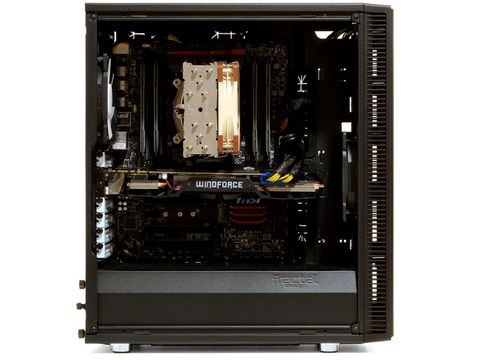Early Verdict
Kudos to Fractal Design for fitting two large radiator mounts within the relatively small dimensions of its Define-C. Had it been just a little cheaper or included just one more fan, it may have won a higher-level award.
Pros
- +
Radiator support
- +
Price
- +
Front pull-filter for bottom panel inlets
- +
Noise-damped pop-out top cover with included magnetic mesh replacement
- +
Small size
Cons
- -
Included fans provide mediocre performance
Why you can trust Tom's Hardware
Introducing The Define-C
The trend of pushing ever-increasing case sizes into the gaming PC market appears to have reversed. External bays were the first things to go as gamers increasingly relied on downloaded content, and large drive racks soon disappeared because many builders no longer need a bunch of 3.5” drives to store their games.
Huge front-panel radiator mounts replaced these items as top builders looked to impress their customers and/or followers with complicated dual-radiator cooling systems. Many buyers now realize that they don’t need both radiators to be enormous when their CPUs draw less than 200W. Knocking out the so-called 420mm radiator requirement reduces case height, just as kicking those drive bays to the curb reduced the need for case depth, allowing us to scale full ATX mid-towers back to late 20th-century proportions.

That’s not to say that everyone will be pleased with a case that supports only two 3.5” hard drives and three more 2.5” SSDs, only that most buyers will figure out that a case like Fractal Design's Define-C can easily fill their needs after careful consideration. Fractal Design’s release timing means that the company believes you’ve already done those calculations and that you're ready to make the leap. If those considerations include noise damping on both side panels, a window-less Define-C is also available at a $5 discount.
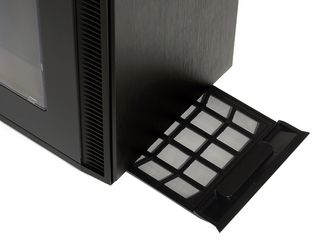
The Define-C includes a full-length bottom panel dust filter that slides out the front, making it unnecessary to turn your case around every time you want to clean that filter. This feature is so highly demanded by so many builders and available on so few cases that some readers will likely demand an award without considering the rest of this review. The rest of us will move on!
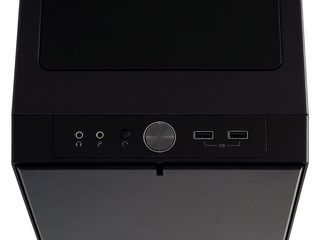
Let it be known that the Define-C is a low-cost enthusiast case that barely breaks into the $80+ market at $85 for the windowed version. That explains why a textured plastic front panel that resembles anodized aluminum under certain lighting angles resembles painted wood from other angles. It also explains why users get only two USB ports and no fan controllers, though some of us aren’t a fan of manual controllers. An aluminum-capped power button gives this otherwise economical unit a touch of class.
MORE: Best Deals
MORE: Hot Bargains @PurchDeals
The Fractal Define-C's Other Half

Snapping the face off, we find a latched front fan grill with an integrated nylon filter screen, covering a 3x 120mm radiator mount with 2x 140mm capability. Front-panel ports are attached to a separate plastic box to ease removal of the panel.
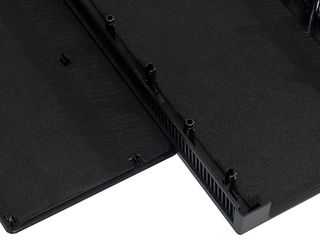
The face and one side panel are damped with cloth-faced asphalt mats, while the top panel fan cover uses damping foam with a matching cloth cover. Builders who want noise reduction on both side panels must order the cheaper, non-window Define-C.
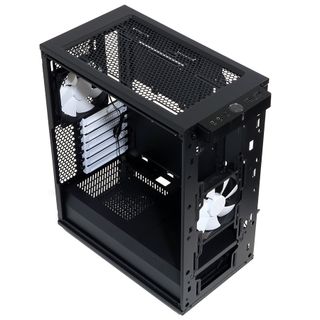
The top panel is just a little too short to fit three 120mm fans, but two 140mm fans can still be placed here with a little room to slide them fore and aft. Builders who choose a two-by-120mm radiator instead are rewarded with 40mm motherboard clearance, which is needed since the 1.2” of space above the motherboard is just a little more than required for fans alone.

Builders who really need a 3x 120mm radiator on the front panel will need to remove the hard drive bay cover, along with its drive cage. Doing so provides access to a 120mm bottom panel fan mount that’s also compatible with a 92mm fan, though Fractal Design doesn’t advertise this alternative.
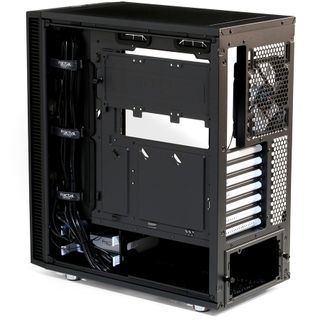
A quick look around back shows that the Define-C has the bare minimum of expansion slots (seven), a 120mm exhaust fan that can be slid vertically to adjust for rear-panel radiator end caps and line fittings, and a very minimal space behind the motherboard tray for cables. Fractal Design focuses the Define-C cable management instead on an inward S-Bend at the front of the motherboard tray, which has cable passages angled towards the motherboard’s front edge but prevents oversized boards (such as the 10.6”-deep premium unit we use in CPU cooler evaluation) from being installed. A removable bracket allows the power supply to be inserted through the back panel, easing cable access within the permanently-attached power supply shroud.


Phillips-head screws that secure the 3.5” drive cage are located above the bottom panel intake filter, while a single thumbscrew that secures the 2.5” triple-drive tray behind the motherboard is far easier to reach. The lower trays feature vibration damping grommets for 3.5” drives, plus solid mounts for additional 2.5” drives. Included shoulder screws prevent the grommets from being crushed.
MORE: Best Cases
MORE: All Case Content
-
blazorthon While I understand this may be the market norm these days, I don't think an $80 price point means that only two USB ports makes sense. $80 is a moderate amount to spend on a case for a typical computer and while more USB ports might not be needed, it's not like the little USB port adapters cost much of anything. There are dozens of sub $40 cases with three or four USB ports.Reply -
thundervore The only thing I can knock this case for is only having 2 USB ports and a 120 fan in the rear.Reply
They got everything else spot on. The ability remove the bottom dust filter from the front of the case, great. Full front dust filter, great. -
rchris Good review, EXCEPT it is very annoying to read case reviews that don't provide even the basic dimensions of the case (H x W x D).Reply -
gilbadon Define S is still my favorite. However, this does have some cool improvements. I wish they made the top look better when the vents are open. I am not a fan of the recessed honeycomb holes.Reply -
RedJaron Reply18814093 said:While I understand this may be the market norm these days, I don't think an $80 price point means that only two USB ports makes sense.
Considering not every mboard has two 3.0 headers on the board, I don't see it a problem of having only two ports on the front of the case. This is a higher-end mainstream case, not a top-shelf model. Can you honestly say you regularly use more than two front ports simultaneously? If so, what for? You're always charging your phone while syncing your Zune while using two flash drives? This is like people saying they need at least 10 USB ports on the back of their mboard.18814329 said:The only think I can knock this case for is only having 2 USB ports and a 120 fan in the rear.
And I'm not sure why the rear fan should be a problem; the case also comes with a 120mm fan in the front. Are you complaining that it's not 140mm? -
Crashman Reply
It's hard for a reviewer to balance out FD's target customer against general expectations. FD is trying to get rid of features that the target customer thinks are in the way, such as USB 2.0 ports, hard drive cages above the power supply shroud, and external bays. It was easy for them to knock a few dollars off for the missing sheet metal back when they launched the Define-S, but the ports...not so much.18814093 said:While I understand this may be the market norm these days, I don't think an $80 price point means that only two USB ports makes sense. $80 is a moderate amount to spend on a case for a typical computer and while more USB ports might not be needed, it's not like the little USB port adapters cost much of anything. There are dozens of sub $40 cases with three or four USB ports.
-
Luminary Thanks for the great review.Reply
Not sure how gung-ho I am about trying this one out, looks like a fairly awkward mid-point with some good features and some things lacking enough to make it not worth the while.
